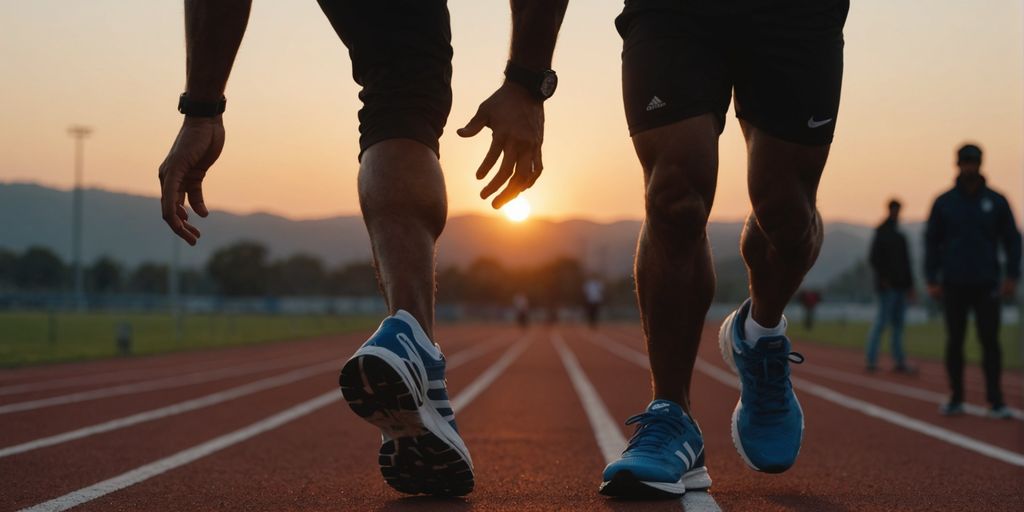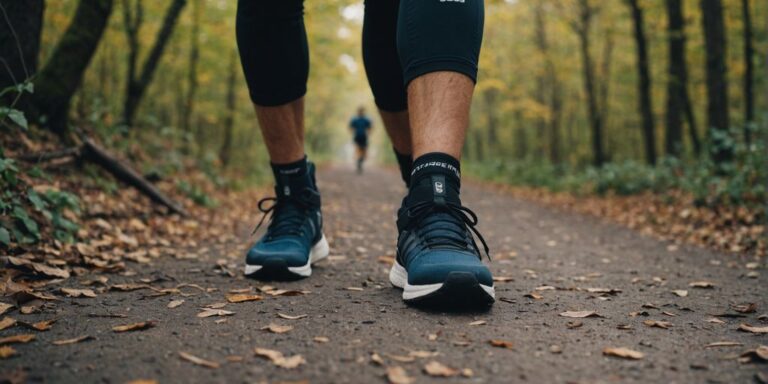Best mobility exercises for runners
Running is a great way to stay fit, but it can be tough on your body. Doing mobility exercises can help keep your joints and muscles in good shape, making your runs smoother and less painful. These exercises are easy to do and don’t need any special equipment, so you can do them anywhere.
Key Takeaways
- Mobility exercises help improve joint movement and muscle flexibility.
- These exercises can make your runs smoother and less painful.
- You don’t need any special equipment to do these exercises.
- Mobility exercises can help prevent injuries.
- Doing these exercises regularly can improve your running performance.
1. Cat-Cow
The Cat-Cow stretch is a simple and effective way to get your spine moving and prevent back pain. This exercise is great for runners who need to keep their back flexible and strong.
To do the Cat-Cow stretch, start in a kneeling table-top position with your knees hip-width apart and your hands shoulder-width apart. As you take a deep breath in, arch your back (cow pose), drop your belly to the floor, and gaze upward. Breathe out and, as you exhale, pull your belly in and round your back (cat pose). Hold each pose for a breath or two and repeat five to 10 times.
This stretch not only helps with flexibility but also promotes better breathing and relaxation.
2. Dynamic Calf Stretch
The Dynamic Calf Stretch is a great way to warm up your muscles before a run. This exercise helps improve mobility and can prevent injuries. First, incorporate dynamic stretches like leg swings and high knees before your run to warm up your muscles and improve mobility.
To perform the Dynamic Calf Stretch:
- Stand facing a wall with your hands on the wall for support.
- Step one foot back, keeping it straight, and bend your front knee.
- Push your back heel down towards the ground until you feel a stretch in your calf.
- Hold for a few seconds, then switch legs.
Repeat this movement several times on each leg to ensure both calves are properly stretched. This stretch is especially useful for runners who want to run pain-free and avoid calf tightness.
3. Arm Circles
Arm circles are a simple yet effective exercise to improve shoulder mobility and warm up your upper body. This exercise is great for runners as it helps loosen up the shoulder joints, which can get tight from repetitive arm movements during running.
To perform arm circles:
- Stand with your feet shoulder-width apart and extend your arms out to your sides, parallel to the ground.
- Start making small circles with your arms, gradually increasing the size of the circles.
- Continue for about 30 seconds, then reverse the direction of the circles for another 30 seconds.
- Lower your arms and relax.
This exercise can be done anywhere and requires no equipment, making it perfect for a quick warm-up before a run.
Incorporating arm circles into your routine can help improve your range of motion and prevent injuries, ensuring you stay in top shape for your runs.
4. Deep Squats
Deep squats are a fantastic exercise for runners. They help improve mobility in your hips, knees, and ankles. To start, stand with your feet shoulder-width apart. Lower your body by pushing your hips back and bending your knees. Keep your chest upright throughout the movement. This exercise targets multiple joints and muscles, making it highly effective.
- Begin standing with your feet at about shoulder width.
- Turn your toes outward about 45 degrees. Keep your knees in line with your toes throughout the movement.
- Descend into a squat by hinging at your hips, then sending them down and back. Allow your arms to come forward to increase the depth of motion.
- Go as low as you can while maintaining a flat back and heel contact with the floor.
- At the bottom of the movement, squeeze your glutes to return to your standing position.
Deep squats are a key part of any mobility routine for runners. They not only enhance flexibility but also build strength in crucial areas.
5. Hip Flexor Stretch

The hip flexor stretch is a fantastic way to loosen up tight hips, especially if you spend a lot of time sitting. This stretch targets the hip flexors, a group of muscles that help lift your leg toward your body. Keeping these muscles flexible is crucial for runners to maintain a good range of motion and prevent injuries.
To perform the hip flexor stretch, follow these steps:
- Start in a lunge position with your right foot forward and your left knee on the ground.
- Push your hips forward gently until you feel a stretch in the front of your left hip.
- Hold the pose for 5 to 10 seconds, either staying still or gently moving your hips back and forth.
- Switch legs and repeat the stretch on the other side.
Doing this stretch regularly can help loosen tight hips in just a few minutes each day. It’s a simple yet effective addition to any runner’s routine.
6. Ankle Circles
Ankle circles are a simple yet effective exercise to improve ankle mobility, which is crucial for runners. Loosening up the ankles before running can help improve your running form and reduce tension in your shins. To perform ankle circles, follow these steps:
- Sit or stand comfortably.
- Lift one foot off the ground.
- Rotate your ankle in a circular motion, making sure to go both clockwise and counterclockwise.
- Repeat 10 times in each direction.
- Switch to the other ankle and repeat.
If you feel any pain or discomfort, stop immediately and consult a doctor. This exercise is especially helpful for those who tend to have stiff ankles, like many heel strikers. By incorporating ankle circles into your routine, you can enhance your mobility and running efficiency.
7. Spinal Twists
Spinal twists are a fantastic way to improve your mobility and flexibility, especially for runners. This exercise helps to loosen up your spine and hips, making it easier to run without stiffness. Here’s how to do it:
- Start by standing with your feet shoulder-width apart and your arms extended out to the sides, parallel to the ground.
- Keep your right leg still and twist your torso to the right, allowing your left leg to pivot slightly.
- Hold the twist for a moment, feeling the stretch in your back and hips.
- Return to the center and repeat on the left side.
- Aim for 10 repetitions on each side.
Benefits of Spinal Twists
- Increases flexibility in the spine and hips.
- Helps with posture, which is crucial for running.
- Can relieve tension in the back, making your runs more comfortable.
Remember, incorporating spinal twists into your routine can be a great way to enhance your overall running performance. Plus, they feel good!
By regularly practicing this exercise, you can enjoy a better range of motion and reduce the risk of injury. So, next time you finish a run, consider adding some spinal twists to your cool-down routine for a nice recovery boost!
8. Leg Swings
Leg swings are a fantastic way to get your body ready for a run. They help improve hip mobility and increase core stability. Forward and backward leg swings are a dynamic warm-up for the lower body that prepares you for physical activity.
To do leg swings:
- Stand tall with your feet flat on the floor.
- Place your hands on your hips or hold onto a wall for balance.
- Swing one leg forward and backward in a controlled motion.
- Repeat for 10-15 swings, then switch to the other leg.
This exercise also increases core stability and balance.
Incorporate leg swings into your warm-up routine to enhance your running performance and reduce the risk of injury.
9. Lateral Lunges
Lateral lunges are a fantastic exercise for runners. They help improve your balance and strengthen your legs. Plus, they can make your hips more flexible.
To do a lateral lunge, start by standing with your feet hip-width apart. Take a wide step to the side, push your hips back, and lower your body until your leg is bent at a 90-degree angle. Make sure your other leg stays straight. Then, push yourself back to the starting position. Repeat on the other side.
Benefits of Lateral Lunges:
- Strengthens leg muscles
- Improves balance
- Increases hip flexibility
Lateral lunges are easy to add to your workout routine. Try doing 10-12 reps on each side. You’ll feel the difference in no time!
10. Glute Bridges

Glute bridges are a fantastic exercise for runners. They help strengthen the glutes, which are essential for running daily. Here’s how to do them:
- Lie on your back with your feet flat on the floor and hip-width apart.
- Lift your hips towards the ceiling, squeezing your glutes at the top.
- Hold for a couple of seconds, then lower back down.
- Repeat for 10-15 reps.
For an added challenge, try the single-leg glute bridge:
- Lie on your back with one foot flat on the floor and the other leg extended towards the ceiling.
- Push up from your lowered foot into a half bridge, keeping your pelvis tucked under.
- Engage the glute of the lowered leg and your core.
- Perform 6-12 reps, then switch legs.
Pro Tip: Glute bridges not only improve your running performance but also help prevent injuries by strengthening your core muscles.
Conclusion
Wrapping it all up, adding mobility exercises to your running routine is a game-changer. These exercises help keep your joints, like your ankles, knees, and hips, moving smoothly. They also make your body more responsive, which is super helpful when you’re running on different terrains. Plus, you don’t need any fancy equipment—just your body and a bit of space. So, whether you’re a newbie or a seasoned runner, give these exercises a try. Your body will thank you, and you’ll likely see a boost in your running performance. Happy running!
Frequently Asked Questions
Is mobility the same as flexibility?
No, mobility is different from flexibility. Mobility is about how well you can move your joints through a range of motion with control. Flexibility is just about how far you can stretch your muscles.
How do mobility exercises help with running?
Mobility exercises help runners by improving joint movement and control. This helps you run better and can even prevent injuries.
Should I do mobility exercises before or after running?
You can do mobility exercises both before and after running. Doing them before helps warm up your joints, and doing them after can help with recovery.
How often should runners do a mobility workout?
Runners should aim to do a mobility workout at least 2-3 times a week to keep their joints healthy and improve performance.
Does mobility increase strength?
Yes, mobility can help increase strength because it improves your range of motion, making your muscles work more effectively.
Can I do mobility exercises on rest days?
Yes, you can do mobility exercises on rest days. They are low-impact and can help with recovery without tiring you out.






